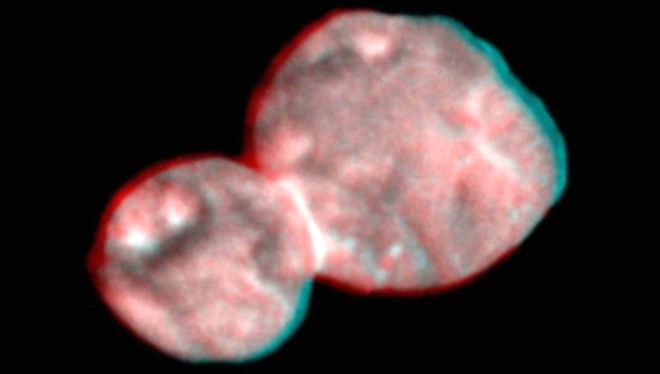The spacecraft that brought the world eye-popping images images of Pluto in 2015 has gone the extra mile – or billions of miles – to bring the world detailed photos of Ultima Thule, an object orbiting the sun just beyond the planets.
Ultima Thule is in what's called the Kuiper Belt, a ribbon of frozen objects that circle the outer ring of the solar system, the same region where Pluto (now downgraded to dwarf-planet status) is located. The ring includes frozen liquids, rocks and comets, as well as dwarf planets.
The object photographed this week was created when two objects – Ultima and Thule – came into contact sometime in the prehistoric past and melded together, giving it its distinctive snowman appearance.
Tyler August, a science communicator at Science North, said the objects melded together rather than exploded when they ran into one another because they were moving so slowly.
“It's actually two little snowballs which, in the very distant past, kind of tapped together and stuck to make a little snowman,” August said. “It is literally shaped like a cosmic snowman ... If they had come together with any real speed, you know, because they're basically snowballs, they would have just blown apart.”
Ultima Thule still orbits the sun, but the farther away an object is from the sun, the slower the orbit. The Earth takes a year to complete its orbit, while Ultima Thule's orbit is measured in centuries.
“Its orbital period is 290 years,” August said. “So it takes a long time. It's in a big wide stretch of space where you have lots of little bits of ice just floating about or spinning around the sun very, very slowly.”
By comparison, nearby Pluto's orbit is 243 years.
Scientists also confirmed that the object is red from radiation and is made up of frozen liquid so cold (about -200 C), it is similar to rock.
August said objects such as Ultima Thule were the building blocks of our solar system, with comparable objects crashing into each other over billions and billions of years to create the planets. He compared it to building something using Legos.
“Imagine you've got a great big bin of Legos and you're going to build planets,” he said. “When you've got eight of them built, you've got a bunch of little bits left over all over the floor.
“And that's what Ultima Thule is, one of these little bits leftover, out very, very far off from the middle of the play area -- which in this analogy, would be the sun.”
And such objects would have changed very little since the solar system formed some 4.5 billion years ago, giving scientists a look at the building blocks of the planets. Bigger picture, August said it fills a few more of the gaps in our knowledge of how the universe formed and where we came from.
“Every world we visit helps us understand all of the worlds of our solar system – and indeed in other solar systems,” he said. “If the only people you meet in your life was your immediate family, you would have a very blinkered view of what people are like in general. Every different world we visit is like meeting a new person, and it helps us build up our sense of what people are like and give us a better understanding of human beings or planets or planetoids in general.”
But what about the name, you might be wondering. What is an 'Ultima Thule'? The word 'Thule' was used by both ancient Greek and Roman writers and mapmakers to describe a distant location far to the north of their countries. 'Ultima' means "farthermost" in Latin. Over time, 'Ultima Thule' came to mean, metaphorically, a place beyond the borders of the known world.
The choice of name has been criticized in some circiels because the German occult movement that gave the Nazi Party its ideas of racial superiority believed Ultima Thule was an ancient land once ruled by a race of Aryan supermen. The Nazis' ideas that racial purity and deliberate breeding could recreate these supermen was born of the myth of Ultima Thule.
